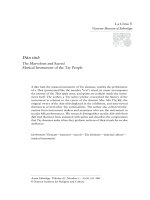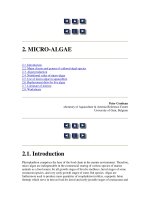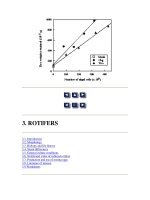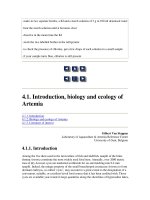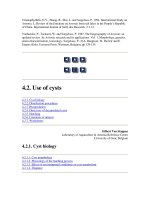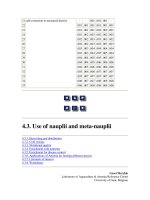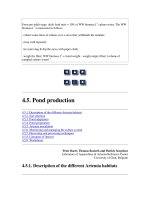Tài liệu Manual on the Production and Use of Live Food for Aquaculture - Phần 4 pptx
Bạn đang xem bản rút gọn của tài liệu. Xem và tải ngay bản đầy đủ của tài liệu tại đây (171.88 KB, 29 trang )
· make in two separate bottles, a KI and a starch solution of 3 g in 100 ml deionised water
· heat the starch solution until it becomes clear
· dissolve in the mean time the KI
· stock the two labelled bottles in the refrigerator
· to check the presence of chlorine, put a few drops of each solution in a small sample
· if your sample turns blue, chlorine is still present
4.1. Introduction, biology and ecology of
Artemia
4.1.1. Introduction
4.1.2. Biology and ecology of Artemia
4.1.3. Literature of interest
Gilbert Van Stappen
Laboratory of Aquaculture & Artemia Reference Center
University of Gent, Belgium
4.1.1. Introduction
Among the live diets used in the larviculture of fish and shellfish, nauplii of the brine
shrimp Artemia constitute the most widely used food item. Annually, over 2000 metric
tons of dry Artemia cysts are marketed worldwide for on-site hatching into 0.4 mm
nauplii. Indeed, the unique property of the small branchiopod crustacean Artemia to form
dormant embryos, so-called ‘cysts’, may account to a great extent to the designation of a
convenient, suitable, or excellent larval food source that it has been credited with. Those
cysts are available year-round in large quantities along the shorelines of hypersaline lakes,
coastal lagoons and solar saltworks scattered over the five continents. After harvesting
and processing, cysts are made available in cans as storable ‘on demand’ live feed. Upon
some 24-h incubation in seawater, these cysts release free-swimming nauplii that can
directly be fed as a nutritious live food source to the larvae of a variety of marine as well
as freshwater organisms, which makes them the most convenient, least labour-intensive
live food available for aquaculture. Although Artemia has been known to man for
centuries, its use as a food for the culture of larval organisms apparently began only in
the 1930’s, when several investigators found that it made an excellent food for newlyhatched fish larvae. During the 1940’s, most commercially available brine shrimp cysts
represented collections from natural saline lakes and coastal saltworks. With the growing
interest for tropical hobby fish in the late 1940’s, commercial value was attached to brine
shrimp, thereby establishing a new industry. Early pioneers exploited in 1951 the cyst
production of Artemia at the Great Salt Lake in Utah, USA. First harvests of the lake
yielded 16 tons of finished product. During the mid-1950’s, commercial attention for
brine shrimp was turned to controlled sources for production in the San Francisco Bay
region. Here it was found that brine shrimp and their cysts could be produced as a byproduct of solar saltworks. Since salt production entails management of the evaporation
process, yearly cyst and biomass productions could be roughly predicted. In the 1960’s,
commercial provisions originated from these few sources in North America and seemed
to be unlimited. However, with the expansion of aquaculture production in the 1970’s,
the demand for Artemia cysts soon exceeded the offer and prices rose exponentially,
turning Artemia into a bottleneck for the expansion of the hatchery aquaculture of marine
fishes and crustaceans. In particular, many developing countries could hardly afford to
import the very expensive cysts.
At the Kyoto FAO Technical Conference on Aquaculture in 1976 it was claimed that the
cyst shortage was an artificial and temporary problem. During the following years
research efforts were made to prove the possibility of local production of Artemia in
developing countries.
At present, Artemia is being produced and exploited on the five continents. Despite this, a
large part of the cyst market is still supplied by harvests from one location, the Great Salt
Lake. This situation makes the market still extremely vulnerable to climatological and/or
ecological changes in this lake, which has been illustrated by the unusually low cyst
harvests in the seasons 1993-1994 and mainly 1994-1995.
Already in the late seventies it appeared that the nutritional value of Artemia, especially
for marine organisms, was not constant but varied among strains and within batches of
each strain, causing unreliable outputs in marine larviculture. Through multidisciplinary
studies in the eighties both the causes for the nutritional variability in Artemia and the
methods to improve poor-quality Artemia were identified. Genotypic and phenotypic
variation (i.e. cyst size, cyst hatching characteristics, caloric content and fatty acid
composition of the nauplii) determine if a particular cyst product is suitable for hatchery
use of specific fish or shrimp species.
By bio-encapsulating specific amounts of particulate or emulsified products rich in highly
unsaturated fatty acids in the brine shrimp metanauplii, the nutritional quality of the
Artemia can be further tailored to suit the predators’ requirements. Application of this
method of bio-encapsulation, also called Artemia enrichment or boosting, has had a major
impact on improved larviculture outputs, not only in terms of survival, growth and
success of metamorphosis of many species of fish and crustaceans, but also with regard
to their quality, e.g. reduced incidence of malformations, improved pigmentation and
stress resistance. The same bio-encapsulation method is now being developed for oral
delivery of vitamins, chemotherapeutics and vaccines.
Furthermore, a better knowledge of the biology of Artemia was at the origin of the
development of other Artemia products, such as disinfected and decapsulated cysts,
various biomass preparates, which presently have application in hatchery, nursery and
broodstock rearing. All these developments resulted in optimized and cost-effective
applications of this live food in hatchery production.
4.1.2. Biology and ecology of Artemia
4.1.2.1. Morphology and life cycle
4.1.2.2. Ecology and natural distribution
4.1.2.3. Taxonomy
4.1.2.4. Strain-specific characteristics
4.1.2.1. Morphology and life cycle
In its natural environment at certain moments of the year Artemia produces cysts that
float at the water surface (Fig. 4.1.1.) and that are thrown ashore by wind and waves.
These cysts are metabolically inactive and do not further develop as long as they are kept
dry. Upon immersion in seawater, the biconcave-shaped cysts hydrate, become spherical,
and within the shell the embryo resumes its interrupted metabolism. After about 20 h the
outer membrane of the cyst bursts (= “breaking”) and the embryo appears, surrounded by
the hatching membrane (Fig. 4.1.2.). While the embryo hangs underneath the empty shell
(= “umbrella” stage) the development of the nauplius is completed and within a short
period of time the hatching membrane is ruptured (= “hatching”) and the free-swimming
nauplius is born (Fig.4.1.3.).
Figure 4.1.1. Harvesting of brine shrimp cysts from a saltpond.
Figure 4.1.2. Cyst in breaking stage. (1) nauplius eye.
Figure 4.1.3. Embryo in “umbrella” stage (left) and instar I nauplius (right). (1)
nauplius eye; (2) antennula; (3) antenna; (4) mandible.
The first larval stage (instar I; 400 to 500 µm in length) has a brownish-orange colour, a
red nauplius eye in the head region and three pairs of appendages: i.e. the first antennae
(sensorial function), the second antennae (locomotory + filter-feeding function) and the
mandibles (food uptake function). The ventral side is covered by a large labrum (food
uptake: transfer of particles from the filtering setae into the mouth). The instar I larva
does not take up food as its digestive system is not functional yet; it thrives completely on
its yolk reserves.
After about 8 h the animal molts into the 2nd larval stage (instar II). Small food particles
(e.g. algal cells, bacteria, detritus) ranging in size from 1 to 50 µm are filtered out by the
2nd antennae and ingested into the functional digestive tract.
The larva grows and differentiates through about 15 molts. Paired lobular appendages are
appearing in the trunk region and differentiate into thoracopods (Fig. 4.1.4.). On both
sides of the nauplius lateral complex eyes are developing (Fig. 4.1.5. and 4.1.6.). From
the 10th instar stage on, important morphological as well as functional changes are taking
place: i.e. the antennae have lost their locomotory function and undergo sexual
differentiation. In males (Fig. 4.1.6. and 4.1.8.) they develop into hooked graspers, while
the female antennae degenerate into sensorial appendages (Fig. 4.1.11.). The thoracopods
are now differentiated into three functional parts (Fig. 4.1.13.), namely the telopodites
and endopodites (locomotory and filter-feeding), and the membranous exopodites (gills).
Figure 4.1.4. Instar V larva. (1) nauplius eye; (2) lateral complex eye; (3) antenna;
(4) labrum; (5) budding of thoracopods; (6) digestive tract.
Figure 4.1.5. Head and anterior thoracic region of instar XII. (1) nauplius eye; (2)
lateral complex eye; (3) antennula; (4) antenna; (5) exopodite; (6) telopodite; (7)
endopodite.
Adult Artemia (± 1 cm in length) have an elongated body with two stalked complex eyes,
a linear digestive tract, sensorial antennulae and 11 pairs of functional thoracopods (Fig.
4.1.10. and 4.1.11.). The male (Fig. 4.1.10.) has a paired penis in the posterior part of the
trunk region (Fig. 4.1.9.). Female Artemia can easily be recognized by the brood pouch or
uterus situated just behind the 11th pair of thoracopods (Fig. 4.1.9. and 4.1.11.). Eggs
develop in two tubular ovaries in the abdomen (Fig. 4.1.7.). Once ripe they become
spherical and migrate via two oviducts into the unpaired uterus.
Figure 4.1.6. Head and thoracic region of young male. (1) antenna; (2) telopodite;
(3) exopodite.
Figure 4.1.7. Posterior thoracic region, abdomen and uterus of fertile female. (1)
ripe eggs in ovary and oviduct.
Figure 4.1.8. Head of an adult male. (1) antenna; (2) antennula; (3) lateral complex
eye; (4) mandible.
Fertilized eggs normally develop into free-swimming nauplii (= ovoviviparous
reproduction) (Fig. 4.1.12.) which are released by the mother. In extreme conditions (e.g.
high salinity, low oxygen levels) the embryos only develop up to the gastrula stage. At
this moment they get surrounded by a thick shell (secreted by the brown shell glands
located in the uterus), enter a state of metabolic standstill or dormancy (diapause) and are
then released by the female (= oviparous reproduction) (Fig. 4.1.14.). In principle both
oviparity and ovoviviparity are found in all Artemia strains, and females can switch inbetween two reproduction cycles from one mode of reproduction to the other. The cysts
usually float in the high salinity waters and are blown ashore where they accumulate and
dry. As a result of this dehydration process the diapause mechanism is generally
inactivated; cysts are now in a state of quiescence and can resume their further embryonic
development when hydrated in optimal hatching conditions.
Under optimal conditions brine shrimp can live for several months, grow from nauplius
to adult in only 8 days time and reproduce at a rate of up to 300 nauplii or cysts every 4
days.
Figure 4.1.9. Artemia couple in riding position. (1) uterus; (2) penis.
Figure 4.1.10. Adult male.
Figure 4.1.11. Adult female.
Figure 4.1.12. Uterus of ovoviviparous Artemia filled with nauplii (first larvae are
being released). (1) ovary with eggs.
Figure 4.1.13. Detail of anterior thoracopods in adult Artemia. (1) exopodite; (2)
telopodite; (3) endopodite.
Figure 4.1.14. Uterus of oviparous Artemia filled with cysts. (1) brown shell glands
(darker colour).
4.1.2.2. Ecology and natural distribution
Artemia populations are found in about 500 natural salt lakes and man-made salterns
scattered throughout the tropical, subtropical and temperate climatic zones, along
coastlines as well as inland (Fig. 4.1.15.). This list still remains provisional as more
extensive survey work should lead to the discovery of many more Artemia biotopes in
different parts of the world (Table 4.1.1.). The distribution of Artemia is discontinuous:
not all highly saline biotopes are populated with Artemia. Although brine shrimp thrive
very well in natural seawater, they cannot migrate from one saline biotope to another via
the seas, as they depend on their physiological adaptations to high salinity to avoid
predation and competition with other filter feeders. Its physiological adaptations to high
salinity provide a very efficient ecological defense against predation, as brine shrimp
possess:
· a very efficient osmoregulatory system;
· the capacity to synthesize very efficient respiratory pigments to cope with the low O2
levels at high salinities;
· the ability to produce dormant cysts when environmental conditions endanger the
survival of the species.
Artemia therefore, is only found at salinities where its predators cannot survive (³ 70 g.l-1).
As a result of extreme physiological stress and water toxicity Artemia dies off at salinities
close to NaCl saturation, i.e. 250 g.l-1 and higher.
Different geographical strains have adapted to widely fluctuating conditions with regard
to temperature (6-35°C), salinity and ionic composition of the biotope. Thalassohaline
waters are concentrated seawaters with NaCl as major salt. They make up most, if not all,
of the coastal Artemia habitats where brines are formed by evaporation of seawater in salt
pans. Other thalassohaline habitats are located inland, such as the Great Salt Lake in Utah,
USA. Athalassohaline Artemia biotopes are located inland and have an ionic composition
that differs greatly from that of natural seawater: there are sulphate waters (e.g. Chaplin
Lake, Saskatchewan, Canada), carbonate waters (e.g. Mono Lake, California, USA), and
potassium-rich waters (e.g. several lakes in Nebraska, USA).
Artemia is a non-selective filter feeder of organic detritus, microscopic algae as well as
bacteria. The Artemia biotopes typically show a very simple trophical structure and low
species diversity; the absence of predators and food competitors allows brine shrimp to
develop into monocultures. As high salinity is the common feature determining the
presence of Artemia, the impact of other parameters (temperature, primary food
production, etc.) may at most affect the abundance of the population and eventually cause
a temporary absence of the species.
As Artemia is incapable of active dispersion, wind and waterfowl (especially flamingos)
are the most important natural dispersion vectors; the floating cysts adhere to feet and
feathers of birds, and when ingested they remain intact for at least a couple of days in the
digestive tract of birds. Consequently the absence of migrating birds is probably the
reason why certain areas that are suitable for Artemia (e.g. salinas along the northeast
coast of Brazil) are not naturally inhabited by brine shrimp.
Next to the natural dispersion of cysts, deliberate inoculation of Artemia in solar salt
works by man has been a common practice in the past. Since the seventies man has been
responsable for several Artemia introductions in South America and Australia, either for
salt production improvement or for aquaculture purposes. Additionally, temporal Artemia
populations are found in tropical areas with a distinct wet and dry season (monsoon
climate), through inoculation in seasonal salt operations (e.g. Central America, Southeast
Asia).
Figure 4.1.15. The world distribution of Artemia.
Table 4.1.1. World distribution of Artemia.
Country
Locality
Sex
Species
Chegga Oase
-
-
Chott Djeloud
-
-
Chott Ouargla
-
-
Dayet Morselli
-
-
Gharabas Lake
-
-
Sebket Djendli
-
-
Sebket Ez Zemouk
-
-
Sebket Oran
-
-
Tougourt
-
-
Port Fouad
B
A. sal
Wadi Natron
B
A. sal
Qarun Lake
P
A. par
Kenya
Elmenteita
-
-
Libya
Mandara
B
A. sp
Ramba-Az-Zallaf (Fezzan)
-
-
Quem el Ma
-
-
Trouna
-
-
Artemia sites in Africa
Algeria
Egypt
Gabr Acun (Fezzan)
-
-
Salins de Diego Suarez
-
-
P(3n)
A. par
Ifaty saltworks
B
A. fra
Larache
P
A. par
Moulaya estuary
-
-
Qued Ammafatma
-
-
Qued Chebeica
-
-
Sebket Bon Areg
-
-
Sebket Zima
-
-
Mozambique
Lagua Quissico
P
A. par
Namibia
Vineta Swakopmund
P(2n, 4n)
A. par
Niger
Teguidda In Tessoun
-
-
Senegal
Dakar
-
-
Lake Kayar
-
-
Lake Retba
-
-
Couga Salt Flats
-
-
Swartkops
-
-
Bekalta
B
A. sal
Chott Ariana
B
A. sal
Chott El Djerid
-
-
Megrine
B
A. sal
Sebket Kowezia
-
-
Sebket mta Moknine
B
A. sal
Sebket Sidi el Hani
-
-
Sfax
B
A. sal
Madagascar
Ankiembe saltworks
Morocco
South Africa
Tunisia
Artemia sites in Australia and New Zealand
New Zealand
Lake Grassmere
B
A. fra
Queensland
Bowen
-
-
Port Alma
B
A. fra
Rockhampton
B
A. fra
South Australia
Dry Creek, Adelaide
P
A. par
West Australia
Dampier
-
-
Lake Mc Leod
-
-
Port Hedland
P
A. par
Rottnest Island
P
A. par
P,B
A.par,A.fra
Akerlund Lake
B
A. sp
Alsask Lake
B
A. sp
Aroma Lake
B
A. sp
Berry Lake
B
A. sp
Boat Lake
B
A. sp
Burn Lake
B
A. sp
Ceylon Lake
B
A. sp
Chain Lake
B
A. sp
Chaplin Lake
B
A. fra
Churchill
B
A. sp
Coral Lake
B
A. sp
Drybore Lake
B
A. sp
Enis Lake
B
A. sp
Frederick Lake
B
A. sp
Fusilier Lake
B
A. sp
Grandora Lake
B
A. sp
Gull Lake
B
A. sp
Hatton Lake
B
A. sp
Horizon Lake
B
A. sp
Ingerbright Nath
B
A. sp
Landis Lake
B
A. sp
La Perouse
B
A. sp
Little Manitou Lake
B
A. fra
Lydden Lake
B
A. sp
Mawer Lake
B
A. sp
Meacham Lake
B
A. sp
Muskiki Lake
B
A. sp
Neola Lake
B
A. sp
Oban Lake
B
A. sp
Richmond Lake
B
A. sp
Shoe Lake
B
A. sp
Shark Bay
Artemia sites in North America
Canada
Snakehole Lake
B
A. sp
B
A. sp
Vincent Lake
B
A. sp
Wheatstone Lake
B
A. sp
Whiteshore Lake
B
A. sp
Kiatuthlana Red Pond
B
A. fra
Kiatuthlana Green Pond
B
A. fra
Carpinteria Slough
B
A. sp
Chula Vista
B
A. sp
Mono Lake
B
A.f. mon
Moss Landing, Monterey Bay
B
A. fra
Owens Lake
B
A. sp
San Diego
B
A. sp
San Francisco Bay
B
A. fra
San Pablo Bay
B
A. fra
Vallejo West Pond
B
A. sp
Christmas Islands
B
A. sp
Hanapepe
B
A. sp
Laysan Atoll
USA Nebraska
A. sp
Verlo West
USA Hawaii
B
Sybouts Lake-West
USA California
A. sp
Sybouts Lake-East
USA Arizona
B
B
A. fra
Alkali Lake
B
A. sp
Ashenburger Lake
B
A. sp
Antioch (Potash)Lake
B
A. fra
Cook Lake
B
A. sp
East Valley Lake
B
A. sp
Grubny Lake
B
A. sp
Homestead Lake
B
A. sp
Jesse Lake
B
A. fra
Johnson Lake
B
A. sp
Lilly Lake
B
A. sp
Reno Lake
B
A. sp
Richardson Lake
B
A. fra
Ryan Lake
B
A. sp
Sheridan County Lake
B
A. sp
Sturgeon Lake
B
A. fra
USA Nevada
Fallon Pond
B
A. fra
USA North Dakota
Miller Lake
B
A. sp
Stink (Williams) Lake
B
A. sp
Laguna del Perro
B
A. sp
Loving Salt Lake
B
A. sp
Quemado
B
A. fra
Zuni Salt Lake
B
A. fra
USA Oregon
Lake Abert
B
A. sp
USA Texas
Cedar Lake
B
A. fra
McKenzies Playa
B
A. sp
Mound Playa
B
A. sp
Playa Thahoka
B
A. sp
Raymondville
B
A. sp
Rich Playa
B
A. sp
Snow drop Playa
B
A. sp
USA Utah
Great Salt Lake
B
A. fra
USA Washington
Cameron Lake
B
A. fra
Deposit Thirteen
B
A. fra
Penley Lake
B
A. fra
Hot (Bitter) Lake
B
A. fra
Omak Plateau
B
A. sp
Soap Lake
B
A. sp
Great Inagua
B
A. sp
Long Island
B
A. sp
San Salvador
B
A. sp
Brit. Virgin Islands
Anegada
B
A. sp
Carribean Islands
Antigua
B
A. sp
St. Kitts
B
A. sp
St. Martin
B
A. sp
South Caicos
B
A. sp
Gulfo Nicova
B
A. sp
Bahia salinas, Guanacaste
B
A. fra
Isla Cabra
B
A. sp
USA New Mexico
Artemia sites in Central America
Bahamas
Costa Rica
Dominican Republic
Las Calderas
B
A. sp
Monte Cristi
B
A. sp
Puerto Alejandro
B
A. sp
Punta Salinas
B
A. sp
Haiti
Grandes salines
B
A. fra
Mexico Baja Calif.
Norte
San Quintin
B
A. fra
B
A. fra
Guerrero Negro
B
A. fra
Isla del Carmen
B
A. fra
Mexico Sonora
Laguna de Yavaros
B
A. fra
Mexico Coahuila
Salinas 5 km SE Cuatrocienegas
B
A. sp
Mexico Chiapas
Laguna del Mar Muerto
B
A. sp
La Joya
B
A. sp
Buenavista
B
A. sp
Los Palos
B
A. sp
Solo Dios
B
A. sp
Carretas
B
A. sp
Pereyra
B
A. sp
Chanchuto
B
A. sp
Panzacola
B
A. sp
Mexico Estado de
Mexico
Brine El Caracol, Sosa Texcoco
B
A. sp
Mexico Oaxaca
Ponds W. Salina Cruz
B
A. sp
Mexico San Luis
Potosi
Las Salinas
B
A. sp
Mexico Sinaloa
Bahia de Ceuta
B
A. sp
Mexico Yucatan
San Crisanto
B
A. sp
Celestun
B
A. sp
Chuburna
B
A. sp
Xtampu
B
A. sp
Las Coloradas
B
A. sp
Aruba
B
A. sp
Bonaire Duinmeer
B
A. fra
Gotomeer
B
A. sp
Pekelmeer
B
A. sp
Mexico Baja Calif. Sur Pichilingue, La Paz
Netherlands Antilles
Martinus
B
A. sp
Slagbaai
B
A. sp
Curaỗao Fuik
B
A. sp
Rifwater
B
A. sp
Nicaragua
Salinas Grandes, Leon
B
A. fra
Puerto Rico
Bahia Salinas
B
A. fra
Bogueron
B
A. sp
Cabo Rojo
B
A. sp
La Parguera
B
A. sp
Ponce
B
A. sp
Tallaboa salterns
B
A. fr
Bahia Blanca
B
A. sp
Buenos Aires
B
A. per
Hidalgo
B
A. per
Mar Chiquita
B
A. sp
Lake Canapa
B
A. sp
Lake Chulluncani
B
A. sp
Lake Hedonia
B
A. sp
Lake Poopo
B
A. sp
Aracati
B
A. sp
Cabo Frio
B
A. fra
Fortaleza
B
A. sp
Icapui
B
A. sp
Macau
B
A. fra
Mundau
B
A. sp
Salar de Surire
B
A. sp
Playa Yape (Iquique)
B
A. sp
Salar de Pintados (I Region)
B
A. sp
Salar de Llamara (II Region)
B
A. sp
B
A. fra
Puerto Viejo (Copiapo)
B
A. sp
La Pampilla (Coquimbo)
B
A. sp
Palo Colorado (Los Vilos)
B
A. sp
Salinas de Cahuil (Pichilemu)
B
A. sp
Artemia sites in South America
Argentina
Bolivia
Brazil
Chile
Salinas de Constitución (VII Región)
A. sp
B
A. sp
Galapagos (S.Salvador)
B
A. fra
B
A. sp
B
A. sp
Caucato
B
A. sp
Chicama
B
A. sp
Chilca
B
A. sp
Estuario de Virrila
B
A. sp
Guadalupe
B
A. sp
Pampa de Salinas
B
A. sp
Pampa Playa Chica
B
A. sp
Puerto Huarmey
B
A. sp
Tumbes
B
A. sp
Boca Chica
B
A. sp
Coya Sal
B
A. sp
Coche
B
A. sp
Coro Coastline
B
A. sp
La Orchila
B
A. sp
Las Aves
B
A. sp
Los Roques
B
A. sp
Port Araya
B
A. sp
Tucacas
B
A. sp
Jinzhou
P
A. par
Yingkou
P(2, 4, 5n)
A. par
Dongjiagou
P(2n)
A. par
Pulandian
Venezuela
B
Salinas
Peru
Galerazamba
Pacoa
Ecuador
A. sp
Manaure
Colombia
B
P(2n)
A. par
P(2, 4, 5n)
A. par
P
A. par
P(2n)
A. par
Luannan
P
A. par
Daqinghe
P
A. par
Huanghua
P(2n)
A. par
Artemia sites in Asia
P.R. China Liaoning
Lushun
Fuzhouwan
P.R. China Hebei
Nanpu
Shangyi
A. sin
Hangu
P(2n)
A. par
P(2, 4, 5n)
A. par
Chengkou
P(2n)
A. par
P(2n)
A. par
Dongfeng
P(2, 5n)
A. par
Gaodao
P
A. par
Xiaotan
P
A. par
Nanwan
P
A. par
Jimo
P
A. par
Xuyu
P
A. par
Lianyungang
P
A. par
Zhanmao
P
A. par
Shunmu
P
A. par
Zhujiajian
P
A. par
Shanyao
P
A. par
Xigang
P
A. par
Huian
P
A. par
P
A. par
Dongfang
P
A. par
Yinggehai
P(2, 4, 5n)
A. par
Aibi
P(2, 4n)
A. par
Dabancheng
P(2, 3, 4,
5n)
A. par
P(2,4n)
A. par
Aletai
P.R. China Fujian
B
Yangkou
P.R. China Zhejiang
A. sin
Tanggu
P.R. China Jiangsu
B
Kangbao
P.R. China Shandong
A. sin
Zhangbei
P.R. China Tianjin
B
B
A. sp
Yanjing
B
A. sp
Shenzha
B
A. sp
Bange
-
-
Gaize
-
-
Geji
-
-
Zhangchaka
-
-
Wumacuo
-
-
P.R. China Guangdong
P.R. China Hainan
P.R. China Xinjiang
Balikun
P.R. China Tibet
Jibuchaka
-
-
Dongcuo
-
-
P(2n)
A. par
Xiaocaidan
P
A. par
Dacaidan
P
A. par
Suban
P
A. par
Keke
P(4n)
A. par
Chaka
P
A. par
Tuosu
P
A. par
P.R. China Gansu
Gaotai
B
A. sp
P.R. China Inner
Mongolia
Haolebaoji(Y)
B
A. sin
(Y = Yimeng Area)
Haotongyin(Y)
B
A. sin
(X = Ximeng Area)
Taigemiao(Y)
B
A. sin
Ejinor(X)
B
A. sin
Beidachi(Y)
B
A. sin
Jilantai
B
A. sin
Wuqiangi
B
A. sin
Shanggendalai(X)
B
A. sin
Dagenor(X)
B
A. sin
Bayannor(X)
B
A. sin
Zhunsaihannor
B
A. sin
Erendabusen
B
A. sin
Chagannor(X)
B
A. sin
Huhetaolergai(Y)
B
A. sin
Hangjinqi
B
A. sin
-
-
P.R. China Qinghai
Gahai
P.R. China Ningxia
P.R. China Shaanxi
Dingbian
-
-
P.R. China Shanxi
Yuncheng
B
A. sin
India Rajasthan
Didwana
-
-
Sambhar Lake
-
-
Gulf of Kutch
P
A. par
Balamba salterns
P
A. par
Mithapur
P
A. par
Jamnagar
-
-
India Gujarat
India Bombay
Vadala
-
-
Bhayander
P
A. par
Bahinder
-
-
Kelambakkam
-
-
Vedaranyam
-
-
Veppalodai
-
-
Pattanamaruthur
-
-
Spic Nagar
-
-
Thirespuram
-
-
Karsewar Island
-
-
Saltwater springs
P
A. par
Harbour
-
-
India Kanyakumari
Thamaraikulam
P
A. par
Iraq
Abu-Graib, Baghdad
P
A. par
Basra
-
-
Dayala
-
-
Mahmoodia
-
-
Urmia Lake
B
A. urm
Schor-Gol
-
-
Shurabil
-
-
Athlit
-
-
Eilat North
P
A. par
Eilat South
-
-
Chang Dao
-
-
Tamano
-
-
Yamaguchi
P
A. par
-
-
India Madras
India Tuticorin
Iran
Israel
Japan
Kuwait
Korea
Pusan
-
-
Pakistan
Karachi saltworks
P
A. par
Sri Lanka
Bundala
-
-
Hambantota
-
-
Palavi
-
-
Putallam
P
A. par
Peinan Salina
-
-
Beimen
B
A. sp
Taiwan
Turkey
Balikesir, Aivalik
-
-
Camalti, Izmir
P
A. par
Tuz Golii
-
-
Ankara Salt Lake
-
-
Konya Karapinar-Meke Salt Lake
-
-
Imbros
-
-
Burgas
P
A. par
Pomorye
-
-
P(4n)
A. par
Strunjan
P
A. par
Ulcinj
P
A. par
Akrotiri Lake
-
-
Larnaca Lake
B
A. sal
Aigues Mortes
P
-
Carnac-Trinité sur Mer
-
-
Guérande-le Croisic
P
A. par
La Palme
-
-
Lavalduc
P
A. par
Mesquer-Assérac
-
-
Porte La Nouvelle
-
-
Salin de Berre
P
A. par
Salin de Fos
-
-
Salin de Giraud
P
A. par
Salins d’Hyères
-
-
Salin des Pesquiers
-
-
Sète
P
A. par
Citros, Pieria
P(4n)
A. par
Megalon Embolon, Thessaloniki
P(4n)
A. par
Kalloni, Lesbos
P(4n)
A. par
Polychnitos, Lesbos
P(4n)
A. par
Mesolongi
P
A. par
Milos Island
P
A. par
Quartu or salina di Poetto, Cagliary
B
A. sal
Artemia sites in Europe
Bulgaria
Croatia
Cyprus
France
Greece
Italy
Secovlje, Portoroz
Carloforte, Sardinia
B
A. sal
Cervia, Ravenna
P(4n)
A. par
Commachio, Ferrara
P(4n)
A. par
P(2,4n)
A. par
B
A. sal
P(2n)
A. par
Tarquinia, Viterbo
B
A. sal
Trapani, Sicily
B
A. sal
Alcochete
P
A. par
Tejo estuary
-
-
Sado estuary
-
-
Ria de Aveiro
-
-
Ria de Farc
-
-
Lake Techirghiol
P
A. par
Lacul Sârat Brâila
P
A. par
Movila Miresii
-
-
Romania Slâric
Prahova
Baia Baciului
P
A. par
Romania Slâric
Prahova
Baia Neagrâ, SP
P
A. par
Baia Verde I, SP
P
A. par
Baia Verde II, SP
P
A. par
Baia Verde III, SP
P
A. par
Baia Rosie, SP
P
A. par
Telega Bâi
P
A. par
Telega II
P
A. par
Telega III
P
A. par
Ocra Sibiului
P?
Sovata
P?
Spain Alava
Añana
P(4n)
A. par
Spain Albacete
Petrola
P(4n)
A. par
Pinilla
P(4n)
A. par
B, P(2, 4n)
mixed
B
m
Margherita di Savoia, Foggia
Sant’ Antioco, Sardinia
Santa Gilla, Sardinia
Siracuse, Sicily
Portugal
Romania
Romania Telega
Spain Alicante
Bonmati, S.Pola
Bras de Port, S.Pola
Calpe
P(2n)
A. par
La Mata
P(2n)
A. par
Molina del Segura
B
Salinera Espanola, S. Pola
B
Villena
B
Spain Burgos
Poza de la Sal
B
A. sp
Spain Cadiz
Sanlucar de Barrameda
P
A. par
Dos hermanos
B, P(2n)
mixed
San Eugenio
B, P(2n)
mixed
San Felix
B
A. sal
San Fernando
B
A. sal
San Juan
B, P
mixed
San Pablo
B, P
mixed
Santa Leocadia
B, P
mixed
B
A. sal
Barbanera
Spain Canary islands
Janubio, Lanzarote
P(2n)
A. par
Spain Cordoba
Encarnacion
P(4n)
A. par
Puente Montilla
P(4n)
A. par
B
A. sal
Spain Formentera
Salinera Espanola,
Spain Guadalajara
Armalla
P(4n)
A. par
Imon
P(4n)
A. par
Olmeda
P(4n)
A. par
Rienda
P(4n)
A. par
Ayamonte
P(2n)
A. par
Lepe
P(2n)
A. par
Isla Cristina
P(2n)
A. par
San Juan del Puerto
B
A. sal
Rolda
P
A. par
Peralta de la Sal
P
A. par
B
A. sal
Spain Huelva
Spain Huesca
Spain Ibiza island
Salinera Espanola
Spain Jaen
San Carlos
Don Benito
Spain Malaga
Fuente de Piedra
Spain Mallorca
Campos del Puerto
Spain Murcia
San Pedro del Pinatar
B
A. sal
Jumilla
B
A. sal
sal. Punta Galera
B
A. sal
sal. Catalana
B
A. sal
Spain Soria
Medinaceli
P(4n)
A. par
Spain Tarragona
Delta del Ebro
P(4n)
A. par
Spain Teruel
Arcos de las Salinas
P(4n)
A. par
Spain Zaragoza
Chiprana
P(4n)
A. par
Bujaralo
P(4n)
A. par
Artemia sites in former USSR
Russia
Bolshoe Otar Mojnaksho
Bolshoe Yarovoe
P
Maloe
Yarovoe/Mojnakshoe/Dscharylgach
Ghenicheskoe
Karachi Lake
Kujalnic liman
P
A. par
Mangyshlak peninsula
Schekulduk
P
Tanatar
B
Kulundinskoe
P
Soljonoe
P
Mirabilit
P
Bolshoe Shklo
P
Kurichye
P
Buazonsor
P
Mormishanskoe A
P
Mormishanskoe B
P
Kutchukskoe
P
P
Kazakhstan
Maraldi
P
Sejten
P
Turkmenistan
Ukraina
P
Popovskoe (=Ojburgskoe)
P
Tchokrakskoe
B
A. par
A. par
Tobetchikskoe
P
Shtormovoe
B
Sakskoe
Sasyk
P = parthenogenetic strain
B = bisexual strain
A. par = Artemia parthenogenetica
A. sal = Artemia salina (= A. tunisiana)
A. fr = Artemia franciscana
A. fr. mon = Artemia franciscana monica
A. per = Artemia persimilis
A. urm = Artemia urmiana
A. sin = Artemia sinica
A. sp = Artemia species (unknown)
4.1.2.3. Taxonomy
The genus Artemia is a complex of sibling species and superspecies, defined by the
criterion of reproductive isolation. Early taxonomists assigned species names to
populations with different morphologies, collected at different temperatures and salinities.
Later on, the profusion of names was abandoned and all brine shrimp was referred to as
Artemia salina Linnaeus 1758. Some authors continue this practice today. Generally,
different names are assigned to reproductively isolated populations or clusters of
populations:
· A. salina Linnaeus 1758: Lymington, England (now extinct), Mediterranean area;
· A. tunisiana Bowen and Sterling 1978 synonym of A. salina;
· A. parthenogenetica Barigozzi 1974, Bowen and Sterling 1978: Europe, Africa, Asia,
Australia;
· A. urmiana Gunther 1900: Iran;
· A. sinica Yaneng 1989: Central and Eastern Asia;
· A. persimilis Piccinelli and Prosdocimi 1968: Argentina;
· A. franciscana superspecies: Americas, Carribean and Pacific islands, including
populations reproductively isolated in nature like A.(franciscana) franciscana Kellogg
1906 and A.(franciscana) monica Verrill 1869 (Mono Lake, California);
· Artemia sp. Pilla and Beardmore 1994: Kazakhstan.
The coexistence of two species in the same saline habitat is possible: mixtures of
parthenogenetic and zygogenetic populations have been reported in Mediterranean
salterns. In addition, commercial aquaculture ventures have seeded salterns with imported
cysts on many occasions; A. Franciscana being introduced throughout Asia, Australia,
and South America over the last 20 years. Because new populations are constantly being
characterised, scientists are urged to use the denomination Artemia sp. unless they have
sufficient biochemical, cytogenetic or morphological evidence to identify the species
name.
The worldwide distribution of brine shrimp in a variety of isolated habitats, each one
characterised by its own ecological conditions, has furthermore resulted in the existence
of numerous geographical strains, or genetically different populations within the same
sibling species; in particular the parthenogenetic Artemia with its di-, tri-, tetra- and
pentaploid populations display a wide genotypic variation. Among these strains a high
degree of genetic variability as well as a unique diversity in various quantitative
characteristics have been observed. Some of these characteristics (i.e. the nutritional
value of freshly-hatched nauplii) are phenotypical, and change from year to year or
season to season. Others, however (i.e. cyst diameter, growth rate, resistance to high
temperature) are strain specific and remain relatively constant, (i.e. they have become
genotypical as a result of long-term adaptations of the strain to the local conditions; see
chapter 4.1.2.4).
4.1.2.4. Strain-specific characteristics
INTRODUCTION
While the nutritional value can be manipulated, other qualities favourable for aquaculture
use can be obtained by selection of strains and/or their cross breeds. Although until
recently over 90% of all marketed cysts originated from the Great Salt Lake, Artemia
cysts are commercially available from various production sources in America, Asia,
Australia and Europe. A knowledge of the characteristics (both genotypic and
phenotypic) of a particular batch of cysts can greatly increase the effectiveness of its
usage in a fish or shrimp hatchery.
SIZE AND ENERGY CONTENT
The nutritional effectiveness of a food organism is primarily determined by its
ingestibility and, as a consequence, by its size and form (see further: chapter 4.3.3.). Data
on biometrics of nauplii from various Artemia strains are given in Table 4.1.2.
Table 4.1.2. Size, individual dry weight and energy content of Artemia instar I
nauplii from different cyst sources hatched in standard conditions (35g.l-1, 25°C)
cyst source
length dry weight energy content
(mm)
(µg)
(10-3 Joule)
San Francisco Bay, CA-USA
428
1.63
366
Macau, Brazil
447
1.74
392
Great Salt Lake, UT-USA
486
2.42
541
Shark Bay, Australia
458
2.47
576
Chaplin Lake, Canada
475
2.04
448
Tanggu, Bohai Bay, PR China 515
3.09
681
Aibi Lake, PR China
515
4.55
-
Yuncheng, PR China
460
2.03
-
Lake Urmiah, Iran
497
-
-
Many strains can be differentiated on the basis of their biometrical characteristics. In
spite of small variations between batches of the same strain, possibly caused by
environmental and/or processing factors, generally the cyst diameter of different
production batches of the same strain remains rather constant. Other biometrical
characteristics such as cyst volume, cyst dry weight, instar I-naupliar length, individual
naupliar weight and naupliar volume, energy content etc., show a high correlation with
the cyst diameter. As a consequence, biometrical parameters, in particular cyst diameter,
are good tools to characterize Artemia strains, and to help to define the origin of unknown
or even mixed cyst samples.
Some general correlations can also be made between sibling species and size:
parthenogenetic Artemia produce large cysts, A. tunisiana large cysts with a thick chorion,
A. franciscana and A. persimilis small or intermediate cysts with a thin chorion.
HATCHING QUALITY
Comparative studies of the hatching behaviour of cysts of different origin show a
considerable variation in hatching percentage, rate and efficiency. However, none of
these parameters is strain specific as they are influenced by a wide array of factors like
harvesting, processing, storage and hatching techniques, as well as production conditions
affecting the parental generation. For optimal use of Artemia in aquaculture the hatching
characteristics of any batch of cysts being used should be known. More information in
this respect is given in chapter 4.2.5.2.
GROWTH RATE OF NAUPLII
Standard culture tests with brine shrimp from different geographical origin show
important differences in growth rate even within the same sibling species, but not among
batches of the same strain (Table 4.1.3.). Although in the field the population growth of
Artemia (i.e. after inoculation) is determined by lots of factors, selection of a strain with a
high potential growth rate will have a positive impact on maximal production output.
TEMPERATURE AND SALINITY TOLERANCE
Both temperature and salinity significantly affect survival and growth, the effect of
temperature being more pronounced. A broad range of temperatures and salinities meets
the requirements for >90% survival. Strains from thalassohaline biotopes share a
common temperature area of preference in the range 20-25°C where mortalities are <10%.
Interaction between temperature and salinity is limited; substantial differences in
tolerance have been recorded at low salinities (around 5 g.l-1) and high temperatures (3034°C). At elevated temperatures the survival of the GSL strain is significantly higher than
for other strains.
Table 4.1.3. Growth of Artemia nauplii from different cyst sources under standard
culture conditions (7 days, darkness, 10 instar I nauplii/25 ml, 35g.l-1, 25°C, fed with
Dunaliella viridis)
cyst source
growth expressed as % recorded for reference
strain
(SFB, batch 1)
San Francisco Bay, CA-USA, batch
1
96
San Francisco Bay, CA-USA, batch
2
96
Macau, Brazil, batch 1
98
Macau, Brazil, batch 2
103
Great Salt Lake, UT-USA, batch 1
125
Great Salt Lake, UT-USA, batch 2
127
Shark Bay, Australia
95
Chaplin Lake, Canada
130
Tanggu, Bohai Bay, PR China
110
Aibi Lake, PR China
105
Yuncheng, PR China
109
LIFE HISTORY TRAITS AND REPRODUCTIVE CAPACITY
Life history and reproductive characteristics of Artemia strains are important factors
when an introduction of brine shrimp in a new habitat is considered, especially when
competition with a local strain is to be expected. These competitive abilities are related to
factors like the length of reproductive, pre- and post-reproductive period, total lifespan,
number of offspring per brood, broods per female, time in-between broods etc. In general
New World (bisexual) populations have a very large number of offspring per brood, a
large number of offspring/day/female and a fast development time to sexual maturity,
which favours this group to Old World bisexual and parthenogenetic Artemia.
